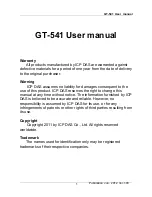
Multi-Protocol Label Switching (MPLS) Support
▀ Overview
▄ Cisco ASR 5x00 Packet Data Network Gateway Administration Guide
416
Overview
As seen in the following scenario, the chassis can be deployed as a router while supporting BGP/MPLS-VPN in a
network.
Chassis as MPLS-Customer Edge (MPLS-CE) connecting to Provider Edge (PE)
Chassis as MPLS-Customer Edge (MPLS-CE) connecting to Autonomous System Border Router (ASBR)
Chassis as MPLS-CE Connecting to PE
Figure 46.
Chassis as MPLS-CE Connected to PE
The system in this scenario uses static/dynamic MPLS labels for ingress and egress traffic. For configuration
information on static label, refer to the
Configuring BGP/MPLS VPN with Static Labels
section and refer
Configuring
BGPMPLS VPN with Dynamic Labels
for dynamic lable configuration.
The system is in a separate autonomous system (AS) from the Provider Edge (PE). It communicates with the PE and all
VPN routes are exchanged over MP-BGP. Routes belonging to different VPNs are logically separated, using separate
virtual route forwarding tables (VRFs).
Routes for each VPN are advertised as VPN-IPv4 routes, where route distinguishers are prepended to regular IPv4
routes to allow them to be unique within the routing table. Route targets added to the BGP extended community
attributes identify different VPN address spaces. The particular upstream BGP peer routing domain (VPN), from which
a route is to be imported by the downstream peer into an appropriate VRF, is identified with an extended community in
the advertised NLRI.
A unique label is also received or advertised for every VPN route.
The Customer Edge (CE) also advertises routes to the PE using NLRIs that include route distinguishers to differentiate
VPNs, an extended community to identify VRFs, and a MPLS-lable, which will later be used to foward data traffic.
There is a single MPLS-capable link between the CE and the PE. MP-BGP communicates across this link as a TCP
session over IP. Data packets are sent bidirectionally as MPLS encapsulated packets.
This solution does not use any MPLS protocols. The MPLS label corresponding to the immediate upstream neighbor
can be statically configured on the downstream router, and similarly in the reverse direction.
When forwarding subscriber packets in the upstream direction to the PE, the CE encapsulates packets with MPLS
headers that identify the upstream VRF (the label sent with the NLRI) and the immediate next hop. When the PE
receives a packet it swaps the label and forward.
















































